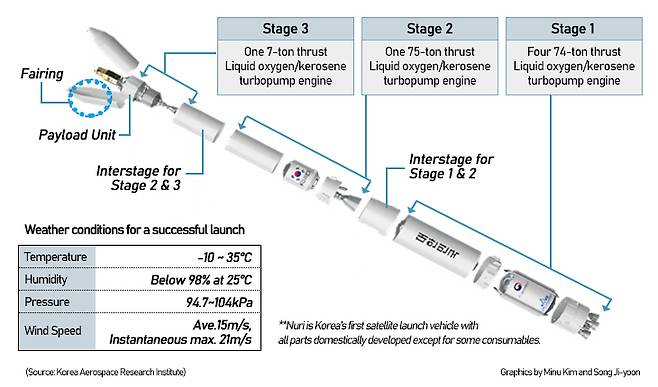S. Korea succeeds in maiden flight of homemade rocket, but fails to put payload into orbit
이 글자크기로 변경됩니다.
(예시) 가장 빠른 뉴스가 있고 다양한 정보, 쌍방향 소통이 숨쉬는 다음뉴스를 만나보세요. 다음뉴스는 국내외 주요이슈와 실시간 속보, 문화생활 및 다양한 분야의 뉴스를 입체적으로 전달하고 있습니다.
![[Photo by Press Corp.]](https://img1.daumcdn.net/thumb/R658x0.q70/?fname=https://t1.daumcdn.net/news/202110/21/mk/20211021182705832weuk.jpg)
The success rate of a new rocket in the first attempt is typically at 30 percent.
Only six – the U.S., France, China, Japan, and India – so far have successfully flown an over 1-ton satellite into orbit without outside help.
The space launch vehicle carried out its three-stage mission to arrive at the destination 700 kilometers (434 miles) above the Earth, but failed to place the 1.5-ton dummy payload into orbit as it ran out of fuel and lost speed about 15 minutes after it blasted off from the Naro Space Center in Goheung, 473 kilometers south of Seoul, at 5 p.m., according to the Korea Aerospace Research Institute (KARI).

The blastoff of a 47-meter-tall rocket soaring into the air was watched live by the nation including President Moon Jae-in.
¡°We did not fully reach the goal. But we have made a credible achievement in the first launch,¡± said Moon in a briefing at the space center.
The 200-ton Nuri rocket was South Korea¡¯s first space vehicle entirely designed and built by Koreans through 11 years of work and cost of 2 trillion won ($1.8 billion). Korea had succeeded in launching its first Naro space rocket in 2013 with the help of the first-stage Russian launch vehicle.
![[Photo by Yonhap]](https://img4.daumcdn.net/thumb/R658x0.q70/?fname=https://t1.daumcdn.net/news/202110/21/mk/20211021182708217ooao.jpg)
After full inspections into fuel and electrical systems, fuels and oxidizers begin to be injected about 4 hours before launch. When all devices remain in a normal state and weather conditions are fine, an automatic launch operation starts 10 minutes before takeoff.
Korea would be testing out the space launch vehicle with a dummy payload again in May 2022 after study on the failures of the first launch.
[¨Ï Maeil Business Newspaper & mk.co.kr, All rights reserved]
Copyright © 매일경제 & mk.co.kr. 무단 전재, 재배포 및 AI학습 이용 금지
- Korea’s Oct.1-20 exports up 36% on yr, imports at sharply 48% growth - Pulse by Maeil Business News Korea
- Korean M&A scene ripe with equity sale instead of buyouts - Pulse by Maeil Business News Korea
- CJ ENM nears finalizing acquisition of controlling stake in SM by offering doubled price - Pulse by Maeil Business News Korea
- Dear U of SM Entertainment eyes to jump on metaverse bandwagon after IPO - Pulse by Maeil Business News Korea
- Korean Inc. turns to young employees for business ideas and management tips - Pulse by Maeil Business News Korea
- 강경준, 상간남 피소…사랑꾼 이미지 타격 [MK픽] - 스타투데이
- ‘결정적 한 수’에 삼성·LG 희비 갈렸다 [맞수맞짱]
- 백아연, 결혼 8개월만에 엄마 된다…“임신 5개월” - MK스포츠
- 이찬원, 이태원 참사에 "노래 못해요" 했다가 봉변 당했다 - 스타투데이
- 양희은·양희경 자매, 오늘(4일) 모친상 - 스타투데이